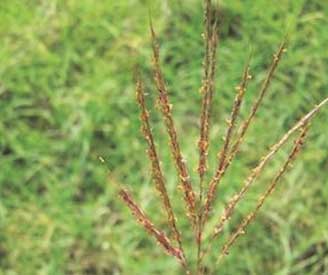Yellow Bluestem
Bothriochloa ischaemum
Description
Perennial, clump-forming, small, blue-gray grass, with flowering stems up to 4 ft. tall. Leaf blades are yellow-green, flat or folded, usually smooth. Leaf sheaths are rounded. The nodes may be smooth or with short hairs. Blooms late June to July, earlier than native bluestems. The inflorescence is silvery, reddishpurple.
Habitat
Found near disturbed roadsides, in pastures, and even in high-quality prairie and glade habitats.
Location in Nebraska
Found in a few counties of Southwest Nebraska.
Pathway of Introduction and Spread
Native to southern Europe and Asia. It and Caucasian bluestem were brought to the United States in the early 1900s for use as forage grass and to control erosion—has since escaped to natural areas. Spreads by root and seed.
Impacts
Are less palatable and less nutritious to cattle than native warm-season grasses, and once established, are almost impossible to eradicate. Can cause an altered carbon-to-nitrogen ratio in the soil that inhibits the growth of native plants. Alters soil function and biota, thereby
suppressing the growth of native grasses.
Karan A. Rawlins, University of Georgia, Bugwood.org

